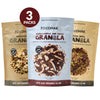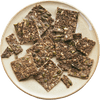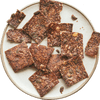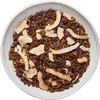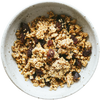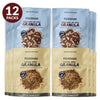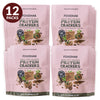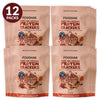
How to Stop Binge Eating and Start Eating Healthy
Reviewed By : Michele Porter - Nutritionist
Characterised by the consumption of a large amount of food in a short period of time, often accompanied by feelings of shame, guilt, and loss of control is precisely what binge eating means. It's a common eating disorder that affects a significant portion of the population with some serious consequences for both physical and mental health, including obesity, diabetes, and depression. If you see yourself as a binge eater, this article is for you, this is a guide for you throughout from how to stop binge eating to start eating healthy.
The Power of Thought
You are what you think, the intangible impulse of thought can be transmuted into its physical counterpart by the application of known principles. However, we can only take you through those principles but the impulse of thought has to come from within. Remember that success is just one step beyond the point at which defeat seems to overtake you. With that thought let's begin this journey.
Most people get better from binge eating disorder with proper support and treatment. Here are the guidelines for you to start from basic to the most effective ways. The first way of dealing with this disorder is - SELF HELP WAY which involves the following steps:
Step 1: Identify Triggers
The first step to stop binge eating is to identify the triggers that cause it. These triggers can vary from person to person but are often related to emotions, such as stress, anxiety, and boredom. Keeping a food diary and tracking your emotions can help identify these triggers. Once identified, it is important to develop alternative coping mechanisms to deal with these emotions, such as exercise, meditation, talking to a friend, or writing a diary. Find a way to give vent to these triggering emotions through some healthy eating habits.
Step 2: Plan Meals
Planning meals in advance and having a balanced diet can help reduce the likelihood of binge eating. Creating a weekly meal plan with a healthy diet and shopping list can help ensure that healthy food options are readily available, reducing the temptation to snack on unhealthy foods. Make realistic meal plans on what to eat and when which can help you regulate your eating. A healthy and balanced diet for someone with binge eating disorder should be similar to this:
- Fill half of your plate with non-starchy vegetables: These include leafy greens, broccoli, cauliflower, asparagus, zucchini, bell peppers, and mushrooms. Vegetables are low in calories and high in fibre, keeping you full and satisfied. Remember, a healthy diet doesn't have to be boring. You have the choice of having healthy yet tasty meals to choose like Miso Stew- it's full of ingredients cannellini beans, mushrooms, onions, carrots, celery, white miso paste, leeks, mustard, agave syrup, tamari soy sauce, garlic, olive oil, corn flour, nutritional yeast flakes, ginseng. Apricot and Olive Tagine and a lot of great healthy options are available at Foodhak.
- Fill a quarter of your plate with lean protein: Your healthy eating plate should have foods such as chicken, fish, beans, lentils, or tofu. It can help reduce cravings and keep you feeling full. At Foodhak you can filter your meals as per your preference. Mapo Tofu, rich in protein, is a meat-free mince, Again, Miso Stew that has white beans, mushrooms, carrots, and leeks to boost the stew’s palette. This juicy concoction is powered by Ginseng, a superfood with anti-inflammatory and antioxidant properties. There are more such protein-rich foods to fill your appetite and enhance your immunity at Foodhak.
- Fill the remaining quarter of your plate with complex carbohydrates: Choose complex carbohydrates such as brown rice, quinoa, sweet potatoes, or whole-grain bread. These foods are high in fibre. At Foodhak Seeded Omega and Millet Crackers which are Crisp savoury crackers made from chia, sunflower, and pumpkin seeds with oregano. These are anti-inflammatory, low glycaemic snacks that help to maintain steady blood sugar, offering a wealth of general health benefits. You can try these snacks at Foodhak as a substitute for your junk food items.
Lastly, include a small serving of healthy fats such as those found in nuts, seeds, avocado, and olive oil, which are important for brain health and can help reduce inflammation in the body.
Step 3: Practise Mindful Eating
Mindful eating is a practice that involves paying attention to the sensations and experiences of eating, such as the taste, smell, and texture of food. It can help reduce the likelihood of binge eating by increasing awareness of hunger and fullness cues, as well as reducing the distractions that can lead to overeating, such as watching TV or using a phone. To practise mindful eating, take the time to savour each bite, chew slowly, and focus on the flavours and textures of the food.
Step 4: Avoid Skipping Meals
Skipping meals can lead to feelings of hunger and can increase the likelihood of binge eating. It is important to eat regular meals throughout the day, including breakfast, to keep your metabolism functioning properly and reduce the likelihood of overeating later in the day. If you are short on time, try to prepare healthy snacks in advance, such as chopped vegetables or fruit, to keep you going throughout the day.
Step 5: Limit Trigger Foods
Trigger foods are foods that are particularly tempting and can lead to binge eating. It is important to identify these foods and limit their consumption. This does not mean that these foods need to be completely eliminated from your diet, but rather that they should be consumed in moderation. If you find that you are unable to control your intake of these foods, it may be necessary to eliminate them from your diet altogether.
If self-help treatment alone is not enough or has not helped you after 4 weeks, you may want to get some professional help.
Step 6: Seek Professional Help
APA ( American Psychiatric Association) recommends that patients with binge-eating disorder be treated with eating disorder-focused cognitive-behavioural therapy or interpersonal therapy, in either individual or group formats. CBT involves talking to a therapist, who will help you explore patterns of thoughts, feelings, and behaviours that could be contributing to your eating disorder.
They will help you:
- Plan out the meals and snacks you should have during the day, to help you adopt regular eating habits
- Work out what is triggering your binge eating.
- Change and manage negative feelings about your body.
- Stick to your new eating habits so you do not relapse into binge eating
All these measures will help you to get out of this habit for sure. But remember consistency is important. And to remain consistent you need to find ways for eating a tasty and healthy diet. And that's where Foodhak comes in as a rescuer, not just nutritional but flavourful meals with diversity in it, across the regions from Japanese to Russian to ayurvedic style, you ask for it and you find something for you, for sure. Meals with the full breakdown of its ingredients, the full calorie count, with the health benefits that meal offers. They provide it all. Fresh, ready-to-eat dishes on your doorstep, can't be more simple. Foodhak isn't like any other platform, they use the latest technology (machine learning) to read thousands of scientific research papers, helping us understand which foods are most beneficial for long-term health. Their freshly prepared ready-to-eat meals are anti-inflammatory, clinically backed, plant-based, and gluten-free. All are delivered conveniently to your doorstep. All this is being said to remind you that you are not alone in this journey, platforms like Foodhak are there to make this journey easy and enjoyable for you.
Also read: Improve your Gut Health, 9 healthy foods for weight loss


